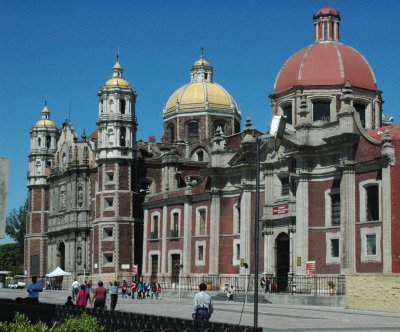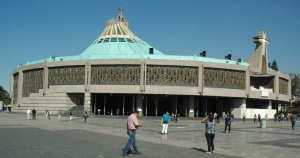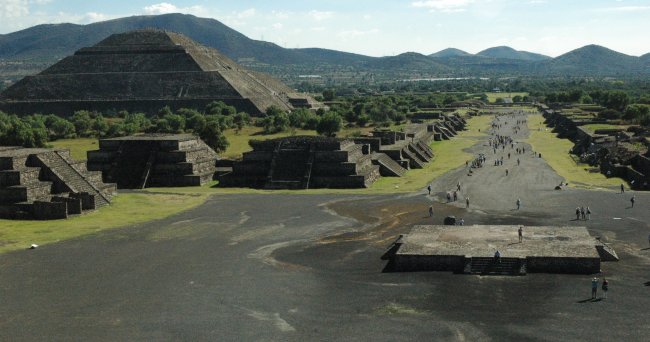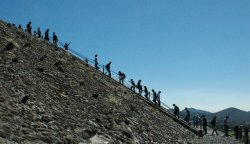Epic monuments and power

Being in Mexico on a sightseeing trip, it is of course necessary to visit some famous churches as well as some Aztec ruins. On Thursday we headed out to do both, though we first had to slowly work our way through Mexico City’s never-ending bumper-to-bumper traffic to get where we were going.
When we got there what struck me the most about the two different tourist sites we visited was how much they resembled each other, despite being separated by almost 1500 years and completely different cultures and religious beliefs.

Our first stop was to see the Basilica of the Guadalupe, located in northern Mexico City. To understand the significance of this site it is important to know the background. According to the story, which is not documented in any writings by clergy at that time, in 1531 native Juan Diego Cuauhtlatoatzin had a series of visions of the Virgin Mary, speaking to him in his native Aztec tongue. In those visions she told him that a church should be built at a specific spot in her honor. Initially his vision was rejected by the clergy when he told them about it. When the Virgin Mary began to work miracles, however, including having her vision miraculously appear on the front of Diego’s cloak, they came to accept the visions and proceeded to build that church as requested. The result was the Basilica, where Diego’s cloak is still housed and is on display for all to see. Juan Diego himself was canonized as a saint in 2002, the Catholic Church’s first indigenous saint from the New World.
The significance of these events for the Catholic Church in Latin America is hard to measure.
It has always struck a strong nerve with the native population, as the story it tells is one where the Virgin comes to a native, who believes and tries to fulfill her wishes. Meanwhile, the powerful church fathers, whites from Spain, are the ones who doubt the vision and in the end must bow to it even though it comes from a poor native. That a cloak with the image of the Virgin Mary still exists and can be viewed by anyone adds strength and reality to the story itself, even though there is no written record from this time period to confirm the story.

Because of its importance, the Basilica is a large facility. The old church building (shown on the left above), though still standing, has some serious structural issues. The front is leaning forward and has only recently been repaired enough for the building to be reopened to the public. Inside, the church is a typical (if one can use that word for such a place) Gothic cathedral, with very high ceilings, incredible stained glass art in the windows, huge magnificent paintings, a gigantic organ, and carvings and gold-plated sculptures that take the breath away. Everyone who enters this space can’t help but be awestruck.
Because of the Basilica’s structural problems, as well as to create a facility that can handle the crowds of pilgrims that come to see it (more than 22 million in 2010), the old building was replaced by a modern Basilica, shown above on the right, where the Guadalupe cloak is displayed and where regular worship services are held. In front of both buildings is a gigantic plaza, also designed to accommodate the many pilgrims that come each year. When Pope John Paul II came (which he did five times), he spoke from a balcony on the new Basilica to a crowd that filled this square, likely exceeding tens of thousands. Times Square on New Years Eve probably looks empty in comparison.
Inside the new Basilica the cloak can be seen at the altar. To see it up close (and photograph it) you go below where there are three moving walkways that take you past it above you. This way, services are not disturbed by those who wish to photograph the image (no flashes).
We then drove out of Mexico City to the Teotihaucan pyramids, probably the most well known large remains of the past Aztec culture that once ruled Mexico. These ruins include two very large pyramids along a two mile long main avenue. The Pyramid of the Moon sits at one end of the street while the largest pyramid, called the Pyramid of the Sun, sits about midway along its length. Visitors can walk along this avenue, climbing up on many of the minor structures that have been uncovered on either side, as well as climb the stairs to the top of the Pyramid of the Sun, which of course we immediately did.

Taken from about halfway up Pyramid of the Moon, looking out at Pyramid of the Sun

Nor we were alone. Hundreds of people were continually trudging up the steep steps during the entire four hours that we were touring the site. The climb itself was not as difficult as I had imagined. The steps were steep, but not so steep that you feared a serious fall. Moreover, a cable handrail gave everyone something to hold onto as they climbed.
I was immediately struck by the many similarities Teotihuacan had with the Basilica of the Guadalupe. Like the Basilica, in front of both pyramids are large plazas, designed to hold large numbers of people coming to observe the religious ceremonies that occurred either at the top of the pyramids, where temples once stood, or on central platforms in the plazas themselves.

Like the Basilica, the Teotihaucan pyramids included major buildings to house and support in style the religious leaders who lived there. Like the Basilica, the Teotihaucan pyramids were designed to inspire awe of the religion and these same religious leaders who organized and ran its ceremonies. And like the Basilica, the Teotihaucan pyramids were designed to express the power of that religious leadership, and act to help cement that power over the general population and the millions who came to see gawk in wonder at these awe-inspiring monuments.
Furthermore, both were significant public works projects, providing employment to thousands but doing little to increase the wealth of the society that had to pay taxes to pay for their construction. In fact, Mexico is strewn with ancient Aztec pyramids and ancient Catholic churches, indicating that both the Aztecs and the Catholic Church focused their efforts on building large monuments, partly as public works but mostly to illustrate the importance and grandeur of their religions. That these public works projects did little to ease the poverty-stricken, destitute, and uneducated state of the peasant native population was irrelevant.
Nor are the Basilica and Teotihaucan unique. They have many similarities to other past top-down empires such as Rome, the Soviet Union, and all of the post medieval king-ruled nation-states of Europe. Each built giant monuments to their greatness in order to instill awe and terror in their subjects.
That I am noting these profound similarities between the Basilica and Teotihaucan pyramids, however, does not mean that I think them identical. Not by any means. The differences were even more profound. (I am about to become extremely politically incorrect, so if you are the kind of person that cannot tolerate reading opinions that challenge accepted wisdoms, you might want to close the page and return to whatever little political hidey-hole you bury your head in so that you can remain feeling safe, secure, and ignorant.).
The pyramids were built by a society that, as far as we know, was mostly illiterate with a relatively limited written language. Even if the upper classes that designed and supervised the construction of the pyramids could read and write, the literature that their religion and culture were based on had to be somewhat parochial. They were building one of the world’s first nation-state civilizations with a relatively poor knowledge of the universe and a somewhat shallow range of philosophical and political thought to base it on.
The Catholic Church, as power-based as it was, had significantly greater advantages. Its founding document was a long, detailed Bible that outlined with great thoroughness the manner in which each person — ruler and ruled — was supposed to live their lives. The church itself had been founded out of the remains of Roman civilization, which in itself had borrowed heavily from the Greeks. Both had provided their own rich and deep cultural, political, and philosophical written literature — centered mostly on ideas of law and justice — to the Biblical roots of the Catholic religion.
Thus, even if the church insisted on ruling from above, it could not in the end prevent its worshipers from reading these documents, and learning for themselves how the God of their religion expected everyone to behave. These cultural roots also insisted that those worshipers be educated, taught to read their Bible, as it believed that all humans are equal under God. Under these circumstances, the power and the rule of the Catholic Church was automatically restricted. Eventually its top down rule would have to bend to the will of those on the bottom. In fact, the very nature of the story of Juan Diego is an illustration of that eventual bending.
In fact, these differences illustrate well the benefits of Western Civilization, and why it has been able to build better human societies these past two thousand years.
Nonetheless, I found the epic top-down manner in which both the Teotihaucan and Spanish Catholic Church ruled to be saddening. They built truly grand things, but they did that first, while the majority of their citizens were still very poor and suffering. Even today the lower classes in Mexico City have a crushingly low standard of living, with the minimum wage 60 pesos per day (less than $4). Though most make more than this, too many do not make that much more.
A much better plan I think would have been to first build a prosperous society, and let its citizens then decide when they themselves could afford to build grand monuments.
This is how the American Puritans/Pilgrims/Quakers did it. They rejected large grand churches. Instead, they focused on the words in the Bible that were written to guide them all in living a good and just life. Combined with freedom and British law, the result was a prosperous and wealthy society where even the poorest peasant lived better than some of the most powerful priests in both the Teotihaucan and early Catholic Mexico. And when that American society finally decided it was time to build its own monuments, it did so freely with a strong moral sense. Its monuments were not so much big buildings, but doing things like winning World War II to bring prosperity and bottom-up rule to the kingdom nation-states of Europe. Americans were even able to put humans on the Moon, and do it in a way that actually enhanced the prosperity of the nation and the world.
What saddened me most in thinking about all this is how few people today recognize the differences between these different cultures. Worse, as I noted earlier, in our modern politically correct culture you aren’t even allowed to note these differences publicly. Instead, you are supposed to make believe that all cultures are the same. To note the differences, no matter how thoughtfully you do it, means you must be condemned as an evil racist who should be burned at the stake.
The result? People come to gape in wonder at these great monuments, and rarely realize how little good they did for the people they were built for. Worse, not being allowed to consider the pros and cons of these different cultures and the monuments they built, people today instead long to build more such monuments. Our modern monuments however are not big pyramids or churches but huge government programs. We get Obamacare, Medicare, OSHA, Social Security, NASA, and any number of other crushing government agencies, none of which do anything to increase the prosperity of our society. Instead they suck the prosperity from it.
This longing for grand monuments must stop. We can admire the work of the past, but to do it better we should do it differently. And building monuments is not the way to do it better.
On Christmas Eve 1968 three Americans became the first humans to visit another world. What they did to celebrate was unexpected and profound, and will be remembered throughout all human history. Genesis: the Story of Apollo 8, Robert Zimmerman's classic history of humanity's first journey to another world, tells that story, and it is now available as both an ebook and an audiobook, both with a foreword by Valerie Anders and a new introduction by Robert Zimmerman.
The print edition can be purchased at Amazon or from any other book seller. If you want an autographed copy the price is $60 for the hardback and $45 for the paperback, plus $8 shipping for each. Go here for purchasing details. The ebook is available everywhere for $5.99 (before discount) at amazon, or direct from my ebook publisher, ebookit. If you buy it from ebookit you don't support the big tech companies and the author gets a bigger cut much sooner.
The audiobook is also available at all these vendors, and is also free with a 30-day trial membership to Audible.
"Not simply about one mission, [Genesis] is also the history of America's quest for the moon... Zimmerman has done a masterful job of tying disparate events together into a solid account of one of America's greatest human triumphs."--San Antonio Express-News


Very thought provoking. Thank you!
Your time away seems to have been interesting and educational, even though some of the things that worry you may have stowed themselves away in your luggage.
It’s chilling to contemplate the decapitated bodies found buried in a chamber inside the Teotihuacan pyramid, as well as children’s graves unearthed at its corners. The parallel I might draw between the huge government programs we’re forced to fund and participate in and the human sacrifices offered up in ancient times is that both sets of rulers undoubtedly told themselves that what they were doing was done for “the greater good” of their inferiors.
I really enjoyed this article, however there are some things that I believe need to be corrected. Here are my comments about them:
Teotihuacan (the pyramids) was not an Aztec civilization. There are several findings that suggest that different cultures lived there, but none of the early civilizations were Aztecs. What is more, there has not been one single pre-Hispanic culture attributed to have lived in Teotihuacan yet. Teotihuacan was built around 200 B.C. and reached its peak close to 500 A.D. If you look at the history of the Aztecs, their peak was close to the 1300 A.D. and 1500 A.D. There are early sightings of the Aztecs from the 6th century, and it is debated whether or not they gave Teotihuacan its name, but one thing is for sure, the Aztecs did not build Teotihuacan. Although, they might have passed through and lived there for a short time.